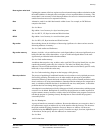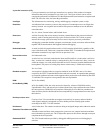
Glossary
ARM DDI 0363E Copyright © 2009 ARM Limited. All rights reserved. Glossary-14
ID013010 Non-Confidential, Unrestricted Access
Unsupported values Specific data values that are not processed by the hardware but bounced to the support code for
completion. These data can include infinities, NaNs, subnormal values, and zeros. An
implementation is free to select which of these values is supported in hardware fully or partially,
or requires assistance from support code to complete the operation. Any exception resulting
from processing unsupported data is trapped to user code if the corresponding exception enable
bit for the exception is set.
Victim A cache line, selected to be discarded to make room for a replacement cache line that is required
as a result of a cache miss. The way in which the victim is selected for eviction is
processor-specific. A victim is also known as a cast out.
Warm reset Also known as a core reset. Initializes the majority of the processor excluding the debug
controller and debug logic. This type of reset is useful if you are using the debugging features
of a processor.
Watchpoint A watchpoint is a mechanism provided by debuggers to halt program execution when the data
contained by a particular memory address is changed. Watchpoints are inserted by the
programmer to enable inspection of register contents, memory locations, and variable values
when memory is written to test that the program is operating correctly. Watchpoints are removed
after the program is successfully tested. See also Breakpoint.
Way See Cache way.
WB See Write-back.
Word A 32-bit data item.
Word-invariant In a word-invariant system, the address of each byte of memory changes when switching
between little-endian and big-endian operation, in such a way that the byte with address A in
one endianness has address A EOR 3 in the other endianness. As a result, each aligned word of
memory always consists of the same four bytes of memory in the same order, regardless of
endianness. The change of endianness occurs because of the change to the byte addresses, not
because the bytes are rearranged. The ARM architecture supports word-invariant systems in
ARMv3 and later versions. When word-invariant support is selected, the behavior of load or
store instructions that are given unaligned addresses is instruction-specific, and is in general not
the expected behavior for an unaligned access.
See also Byte-invariant.
Write Writes are defined as operations that have the semantics of a store. That is, the ARM instructions
SRS
,
STM
,
STRD
,
STC
,
STRT
,
STRH
,
STRB
,
STRBT
,
STREX
,
SWP
, and
SWPB
, and the Thumb instructions
STM
,
STR
,
STRH
,
STRB
, and
PUSH
.
Write-back (WB) In a write-back cache, data is only written to main memory when it is forced out of the cache on
line replacement following a cache miss. Otherwise, writes by the processor only update the
cache. Also known as copyback.
Write buffer A block of high-speed memory, arranged as a FIFO buffer, between the data cache and main
memory, whose purpose is to optimize stores to main memory.
Write completion The memory system indicates to the processor that a write has been completed at a point in the
transaction where the memory system is able to guarantee that the effect of the write is visible
to all processors in the system. This is not the case if the write is associated with a memory
synchronization primitive, or is to a Device or Strongly Ordered region. In these cases the
memory system might only indicate completion of the write when the access has affected the
state of the target, unless it is impossible to distinguish between having the effect of the write
visible and having the state of target updated. This stricter requirement for some types of
memory ensures that any side-effects of the memory access can be guaranteed by the processor
to have taken place. You can use this to prevent the starting of a subsequent operation in the
program order until the side-effects are visible.


















